Technical Questions Asked In SSB Interview pdf – Service Selection Board
Explain Pythagoras Theorem?
It involves a right triangle. Right triangle is a triangle with a right angle in it. The longest side of a right triangle is called the ‘hypotenuse’. It is the side opposite of the right angle.
Pythagoras Formula
a2 + b2 = c2
This theorem was discovered by Pythagoras, a Greek mathematician and philosopher who lived between approximately 569 BC and 500 BC.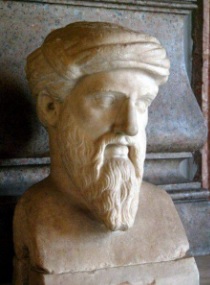
This theorem state that “In any right-angled triangle, the square of the hypotenuse is equal to the sum of squares of the other two sides.”
Proof of Pythagoras Theorem
We have cut four congruent right-angled triangles. Keep them in order as shown.

After combining above four triangle, become figure ABCD which is a square with side length a + b . It consists of the four congruent right-angled triangles and a square, EFGH, with side length c.
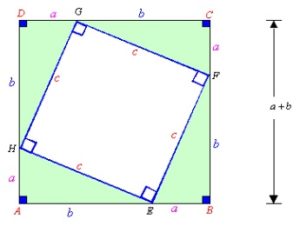
Area of square ABCD = (a+b)2 ……….. (1)
Also, Area of square ABCD = 4 × Area of △EBF + c2
= 4 × (1/2 ab) + c2
= 2ab + c2 ………… (2)
From (1) and (2),
2ab + c2 = (a+b)2
2ab + c2 = a2 + b2 + 2ab
c2 = a2 + b2
Hence proved.
Physics
Laws of Motion. Their Application In Everyday Life
Motion is a change in position. It is also called velocity. Velocity is related to acceleration. Force generate the acceleration. Force is a push or pull which can change state of any body.
Types of Force
(i) Gravitational Forces – due to which are standing on earth.
(ii) Electromagnetic Forces – Electrons or Proton in atom attract or distract each other.
(iii) Nuclear Forces – short range force
(iv) Weak Forces – short range force
Newton’s First Law of Motion
Newton’s first law of motion defines that a body continuous to maintain its state of rest or of uniform motion unless acted upon by an external unbalanced force. This first law of motion is also called the law of inertia. If balanced forces act on an object, it doesn’t accelerate or change direction. This means it doesn’t change its velocity and it doesn’t have momentum.
This law is for balanced force. Fext = 0, No change in physical state of body.
Rest —> Rest
Moving —> Moving
i.e. No change in velocity.
Example: A rider on a running horse is thrown forward when the horse stops suddenly due to law of inertia.
Newton’s Second Law of Motion
Newton’s second law of motion defines that the net force of an object is equal to the mass of the object multiplied by its acceleration or simply the law of acceleration
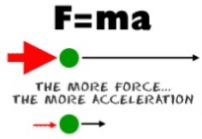
This is for unbalanced force. If Fext Not = 0, acceleration = Fext/mass. Where Fext can be sum of number of forces.
a = F/M
F = ma
i.e. velocity will change and acceleration will be in same direction as force because mass is a scalar quantity.
The more mass the object has the more net force has to be used to move it.
Example : If you use the same force to push a truck and push a car, the car will have more acceleration than the truck, because the car has less mass.
Newton’s Third Law of Motion
Newton’s third law of motion defines that to every action there is an equal and opposite reaction that acts with the same momentum and the opposite velocity.

Example : When you jump off a small rowing boat into water, you will push yourself forward towards the water. The same force you used to push forward will make the boat move backwards.
Archimedes Principle
“When an object is immersed in a liquid the apparent loss of weight of an object is equal to the upthrust and this is also equal to the weight of the liquid displaced”. Archimedes Principle is also known as Law of Buoyancy. It is in BC 287 – BC 212.
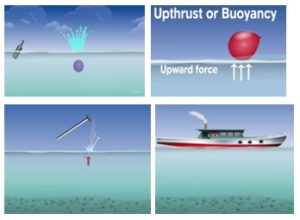
We are aware of the fact that some object float in water while other sink. Let’s look at balloon. Do you know what makes a balloon float on water? It’s the upward force exerted by water that makes the balloon float. To experienced this, try pushing the balloon under water you will feel an upward force that makes it difficult to push the balloon down now release the balloon, it bounces back to the surface what happen here is that the applied force acts in the downward direction pushing the balloon down but the water exerts an upward force on the balloon pushing it up this upward exerted by water in the balloon is known as upthrust or buoyancy. the upward force is called the buoyant force.
Have you ever wondered why iron kneel sinks while a huge iron ship floats on water. Let’s the iron nail sinks as it is solid and compact with less volume in water and it’s density is greater than water. Thus the upthrust exerted by water on the kneel is less than the weight of the nail. This causes it to sink and iron ship floats as it is hollow filled with air and occupies more volume in water and it’s density is less than water. Thus the upthrust exerted by water on the ship is greater than weight of the ship letting it float.
These example indicates that the magnitude of the buoyant force depends on the volume (V) of the immersed part of the body and the density Rho of the fluid and the acceleration due to gravity G. Thus Upthrust or Buoyant force = Vpg
Uses of Archimedes principle
- Designing of ships
- Submarine hydrometer is used to find the specific gravity of liquid.
- Lacto meters used to determine the purity of milk.
Note : When a body is partially immersed in a fluid, it experiences an upward force that is equal to the weight of the fluid displaced by it.
Three switches, Three Bulb, Time according – Puzzle
IQ Test – There is a room with a door (closed) and three light bulbs. Outside the room there are three switches, connected to the bulbs. You may manipulate the switches as you wish, but once you open the door you can’t change them. Identify each switch with its bulb?
Difference between Petrol and Diesel Engine
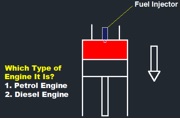
| Diesel Engine | Petrol Engine |
| Diesel Cycle | Otto Cycle |
| Without Spark Plug | Spark Plug |
| Compression Ignition | Spark Ignition |
| More maintenance | Less Maintenance |
| 40 – 45% Thermal Efficiency | 25-30% Thermal Efficiency |
| Cold Area – Starting Problem | No Starting Problem |
| High Compression Ratio (14:1 to 25:1) | Low Compression Ratio (8:1 to 12:1) |
| More Noise | Less Noise |
| Pre ignition is not possible | Pre ignition is possible |
| Engine weight is more & occupy more space | Less Engine Weight & occupy less space |
| Greater Mileage | Less Mileage |
| Less Acceleration | More Acceleration |
| More Torque (Nm) | Less Torque |
| Less Power | More Power |
| Fuel is fed into the cylinder by a fuel injector is mixed with air inside the cylinder | The air and petrol are mixed in the carburetor before they enter into the cylinder. |
| Pressure end of the compression is 33 bar | Only 10 bar |
| Burn Fuel is less volatility | Burn Fuel is more volatility |
| Constant pressure cycle | Constant volume cycle |
| Air intake | Air + Fuel Mixture will Intake |
| Only Air Compressed | Air & Fuel compressed |
| Ignition take place using compression | Ignition take place using pressure |
| More Polluting | Less Polluting |
| Used in heavy vehicles which require high power. Eg: bushes, trucks, locomotive etc. | Used in light vehicles which requires less power. Eg: car, jeep, motorcycle, scooter etc. |
How do a airplane Fly?
Many crazy flying machine designs were tested in the nineteenth century because of mankind’s quest to fly. Finally one attempt succeeded. It was the flight of the Wright brothers. Their aircraft was a success by airfoil technology. The wing of the aircraft was able to produce a lift force in an ingenious way. The wing has a curved shape. This shape pushes the gushing air downwards. Newton’s third law of motion come into picture here. If the wing pushes the air downwards, the air should also push the wing in opposite direction with an equal magnitude. This eventually results in the lift force and the aircraft will be able to fly off the ground.
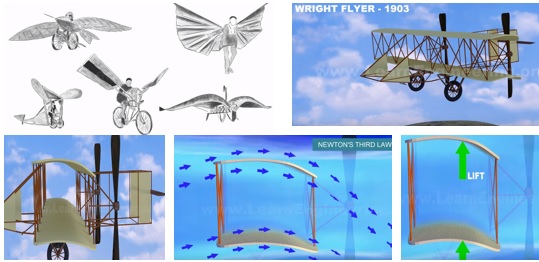
Even today the airplanes make use of the same airfoil technology to fly but with a highly aerodynamically optimised airfoil shape. Thrust force makes an airplane move forward. To produce a thrust, a turbofan engine is used in modern civil aviation aircraft. Reaction force of high-velocity exit jet gives the turbofan engine thrust force. To produce high velocity jet, the incoming air is passed through a compressor, combustion chamber and turbines stage. The engines also drives the thrust force from the fans reaction. Thus the turbofan engines produce a great amount of thrust and make the airplane move forward.
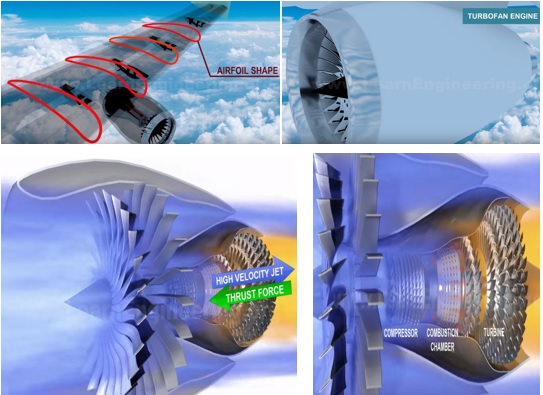
As discussed earlier when the airplane moves forward the relatively flowing air over the wing will produce a lift force on the wings. The wings of a modern aircraft is a collection of different parts. During the take off, the flaps and slats are extended downwards. Thus increase the wing area and curvature of the airfoil. As the curvature increases air will be deflected more. Thus a greater lift force can be derived even at low airplane speed. As the airplane speed increases, the lift force rises. Finally when the lift is more than the gravitational force, the plane takes off.
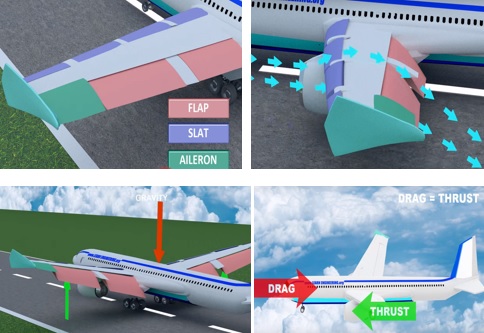
During the normal flight, the flaps and slats are put it to its original position. It is interesting to note that different force acting on the airplane balance exactly each other during the normal flight.
Now, let’s get into the core of the flight navigation. You can navigate the airplane the way you want with the help of three different wing attachments.
- AILERON
- ELEVATOR
- RUDDER
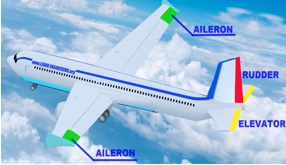
Pilot use them alone or together depending on the situation. Assume you want to descend the airplane, you can lower the elevator. This will deflect the flow and will produce a lift. This lift force will create a moment that will make the nose of the plane go down. If you want to climb up, just do the reverse.
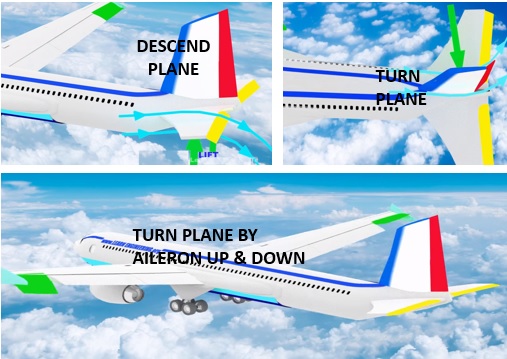
Note : Pilots sometimes use both Aileron & Rudder for the smooth orientation.
Now let’s assume that the airplan has to change its path. You must have an obvious answer in your mind. Just turn the rudder. Of course, turning the rudder will produce a lift force and make the airplane turn . But, such a sudden change in flight direction may cause passenger discomfort. The professional use of Ailerons. Just make one Aileron go up and the other down. This will cause difference in the lift forces and the airplane will roll. All these movement of flaps and other devices are controlled from the cockpit using a Fly-by-Wire system. In FBW systems, the controllercomputer governs exact movement of actuators for a smooth operation.
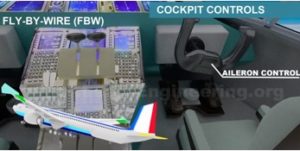
Fuel required for the airplane is stored in the large tanks of the wing. During landing, it is required to increase the drag. For this purpose, the flaps and slats are activated again. Because they have drag racing capability too. A wing attachment called spoiler is also activated to increase the drag further and reduce the lift.
Explain between AK-47 vs INSAS?

AK-47
Type : Assault Rifle
Place of origin : Soviet Union
Designer : Mikhail Kalashnikov
Designed : 1947
Manufacturer : Kalashnikov concern and Norinco
Weight : Without magazine 3.47 Kg (7.7 lb)
Length : 87 cm
Barrel Length : 415 mm
Muzzle Velocity : 715 m/s
Effective Firing Range : 350 m (380 yd)
Rate of fire : 600 rounds/min
INSAS Rifle
INSAS stands for Indian Small Arms System
Type : Assault rifle (LMG)
Place of Origin : India
Designer : ARDE (Armament Research and Development Establishment)
Manufacturer : OFB (Ordinance Factory Board)
Weight : 4.15 Kg without magazine
Length : 960 mm
Barrel Length : 464 mm
Mozzle velocity : 900 m/s
Rate of Fire : 600 – 650 rounds/min
Effective Firing Range : 400 m insas rifle
INSAS is basically a reverse engineered version of AK-47
INSAS does not have automatic mode firing like AK. Therefore, reduced fire rate.
The AK magazine is made of steel and is opaque, thus one is not aware as to how many rounds are left, while firing unless counted, however INSAS magazine is translucent and thus it is easy to know when your magazine is nearing empty.
INSAS is longer and heavier.
The butt of AK47 is inherently foldable whereas that of insas is fixed. However other versions of both the weapons exist but are uncommon in Indian Army.
The cost of production INSAS is more than the cost of AK47 imported which may be due to the heavy production in other countries.
Chemistry
Hydrogen Bonding
Hydrogen bonding is the strong attraction between a hydrogen atom bonded to a highly electromagnetic atom in one molecule and a highly electromagnetic atom in another molecule. It is an inter-molecular bond between molecules. Example : H2O

Cohesion is the inter-molecular attraction between like molecules. But Adhesion is attraction between unlike molecules.
Surface tension is the amount of energy required to stretch or increase the surface of a liquid by a unit area.
Technical Questions Asked In SSB Interview pdf download
Candidates can download technical questions asked in SSB Interview pdf by clicking on below link.
Technical Questions asked SSB Interview pdf
All the best for your upcoming exam!
You can join or visit at Facebook Page or Twitter for always keep in touch with further updates.
Read more articles….

sir
aap ke nots bahut achchhe hain jo mere bahut kaam arahe hain lekin english me hone ke karan kaum samgjj me aate hain to kya aap hindi me nots bhej sakte hain 10th ki math aur scienc
Thank you Saurav, We will continue to post like this….